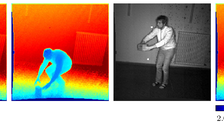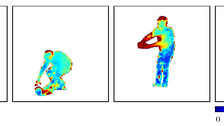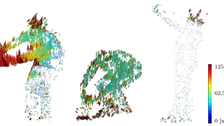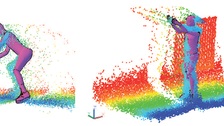Automatic techniques for 3D reconstruction of critical workplace body postures
Project title
PointCloud-4D – Development of methods for automatic 3D motion analysis based on range imaging data, sub-project: Structured 3D motion analysis based on range image sequences
Funding
The Central Innovation Program for SME (ZIM) on behalf of the Federal Ministry for Economic Affairs and Energy (BMWi)
Motivation
In many jobs, work life is full of awkward postures. This may be everything between overhead work, bending, squatting or kneeling to a combination of critical postures of the head, torso and extremities. In Germany, in 2012 around 4.8 million employees worked in unfavourable, forced postures. With a share of 24.4%, musculoskeletal disorders cause most of the days of incapacity to work, and with 9.1 billion euro loss of production, they form a great entrepreneurial potential for prevention. In order to identify and prevent or at least reduce harmful effects on human health, ergonomic workplace and risk analyses are required by German and European law (Machinery Directive 2006/42/EC; German Occupational Safety and Health Act).
Risk analyses are usually realised by well-trained experts who interactively analyse field observation data surveyed. Taking aspects of efficiency and objectiveness into account, the data-intensive documentation of body postures in real work processes and the corresponding data evaluation present a challenge. So far, so called paper-and-pencil tests or sometimes video-aided methods are only gradually being replaced by automated measuring techniques.
Aims
Together with our project partners, we develop techniques for the determination of structured motion parameters from range camera image sequences. The core contribution of the work is the development of an integrated least squares 3D tracking approach based on amplitude and range image sequences to calculate dense 3D motion vector fields. Geometric primitives of a human body model are fitted to time series of range camera point clouds using these vector fields as additional information. Body poses and motion information for individual body parts are derived from the model fit. On the basis of these pose and motion parameters, critical body postures are detected. The primary aim of the project is to automate ergonomic studies for risk assessments regulated by law, identifying harmful movements and awkward body postures in a workplace.
3D cameras based on photomix detectors or similar principles simultaneously produce both a grey value image and a range image. Functioning as single image sensors, they deliver spatially resolved surface data at video rate without the need for stereoscopic image matching. In the case of 3D motion analyses in particular, this leads to considerable reductions in complexity and computing time. 3D cameras combine the practicality of a digital camera with the 3D data acquisition potential of conventional surface measurement systems. Despite the relatively low spatial resolution currently achievable, as a monosensory real-time depth image acquisition system they represent an interesting alternative in the field of 3D motion analysis.
The use of 3D cameras as measuring instruments requires the development of algorithms for structured 3D motion analysis based on range imaging sequences, and indeed the development of procedures for fitting parameterized CAD volume objects in 3D camera point clouds. In a first instance, motion vectors are calculated by 2.5D least squares tracking for all 3D body points. This motion data provide a valuable basis for the following potential energy surface model fit. Finally, a risk model is defined to assess and document the entire body posture resp. single body parts.
The system offers people working in the field of ergonomic a helpful tool for an objective and efficient assessment of the working conditions as well as for the documentation of the results. At the same time, interesting novel application fields open up for photogrammetry.
Tasks
The Chair of Photogrammetry will treat the following tasks:
- Further development and evaluation of an integrated 2.5D least squares tracking approach
- Segmentation of 3D camera intensity and range images as well as motion vector fields
- Motion segment integration in top-down fitting approach developed by kubit GmbH
in order to assure that the heterogeneous information pool is fully exploited

© IPF

© IPF
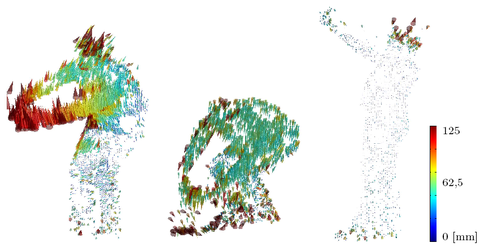
© IPF
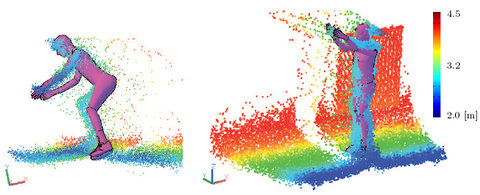
© IPF
Related Publications
ProjeCt PartnerS
- Dr.-Ing. Oliver Bringmann, Dipl.-Inf. Armin Schmich, Dipl.-Inf. Tilo Pfliegner (kubit GmbH - Software für Vermessung und Datenerfassung)
- Prof. Dr.-Ing. Martin Schmauder, Dipl.-Ing. Daniel Gröllich (Professur für Arbeitswissenschaften)
Contact
- Prof. Dr. habil. Hans-Gerd Maas (project management)
- Dipl.-Ing. Patrick Westfeld (project work)

